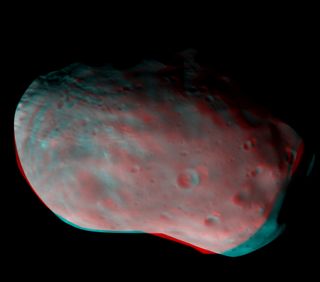European Probe Snaps Color Photos of Martian Moon Phobos

The European Space Agency's Trace Gas Orbiter orbiting Mars has snapped its first views of Phobos, the largest of two moons circling the Red Planet.
The Trace Gas Orbiter, or TGO, is part of the European ExoMars exploration program and arrived in orbit around Mars on Oct. 19. The orbiter snapped the new views of Phobos during its second orbit Mars. It was the second half of a series of test science measurements, with the first half focused on Mars itself during its first orbit.
TGO captured the images used to make the composite view seen here while the probe was about 4,784 miles (7,700 kilometers) from Phobos. The camera collected two images with each of its four color filters which are optimized to show distinctions in the mineral makeup of the Martian satellite. These differences show up as the "bluer" or "redder" colors in the image. [Phobos and Deimos: Pictures of Mars' Moons]
By using images the blue-green and red filters, a 3D image was produced as well.

"Although higher-resolution images of Phobos have been returned by other missions, such as ESA's Mars Express and NASA's Mars Reconnaissance Orbiter, this provided a good test of what can be done with our data in a very short time," Nick Thomas, principal investigator of TGO's CaSSIS camera team at the University of Bern, said in a statement. "The images have given us a lot of useful information about the color calibration of the camera and its internal timing."
With testing of the ExoMars instruments underway, team members focus on getting the craft into it's near-circular science orbit by the end of 2017 through aerobraking.
The leading scientific goal for TGO's mission is to gather detailed records of rare gases in Mars' atmosphere — methane, water vapor, nitrogen dioxide and acetylene, which compose less than 1 percent of the atmosphere's volume.
Get the Space.com Newsletter
Breaking space news, the latest updates on rocket launches, skywatching events and more!
Methane is of particular interest because Earth's methane is primarily produced thanks to biological activity, with some contributed by hydrothermal reactions. ExoMars also hopes to uncover whether water or ice exists just below the surface. Color and stereo images of the surface will aid in these findings.
TGO will serve as a data relay for current and future crafts on the surface of Mars, including the 2020 ExoMars mission featuring a rover and surface science platform.
Follow us @Spacedotcom, Facebook or Google+. Original article on Space.com.
Join our Space Forums to keep talking space on the latest missions, night sky and more! And if you have a news tip, correction or comment, let us know at: community@space.com.

Christine Lunsford joined the Space.com team in 2010 as a freelance producer and later became a contributing writer, covering astrophotography images, astronomy photos and amazing space galleries and more. During her more than 10 years with Space.com, oversaw the site's monthly skywatching updates and produced overnight features and stories on the latest space discoveries. She enjoys learning about subjects of all kinds.